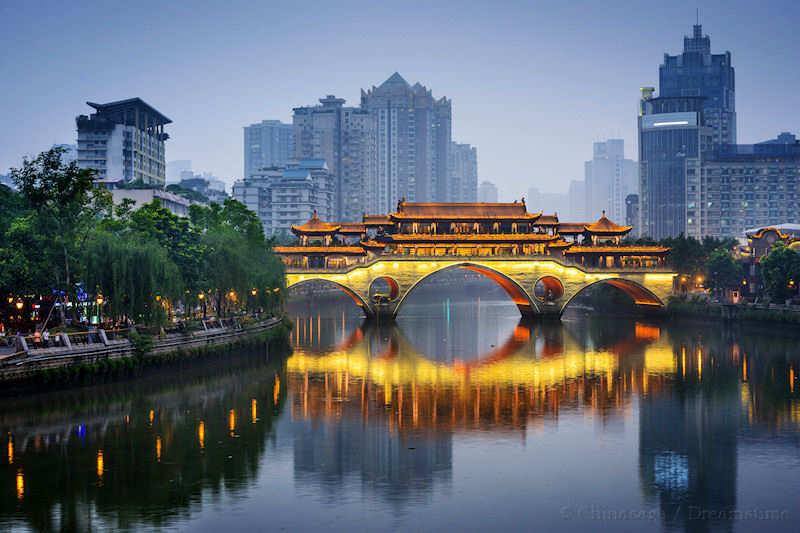Where is Sichuan province?

Sichuan is one of China’s 23 provinces and the capital of Chengdu. Located inland in Southwest China and in the upper reaches of the Yangtze River, it is known as the “land of abundance”.
| Capital | Chengdu |
| Divisions | 21 prefectures, 181 counties, 5011 townships |
| Government Type | Province |
| Area | 485,000 km2 (187,000 sq mi) |
| Highest elevation (Mount Gongga) | 7,556 m (24,790 ft) |
| Population | 83,674,866 |
| Population Density | 170/km2 (450/sq mi) |
It is one of the birthplaces of Taoism in China, the birthplace of ancient Shu civilization, and the place where the earliest paper money “Jiaozi” appeared in the world. Sichuan salt industry culture and wine culture have a long history.
The culture of the Three Kingdoms, the culture of the Red Army, and the culture of the Ba people are wonderful. It is bounded between 26 ° 03 ′~ 34 ° 19 ′ N and 97 ° 21 ′~ 108 ° 12 ′ e, and borders seven provinces such as Chongqing, Guizhou, Yunnan, Tibet, Qinghai, Gansu, and Shaanxi.
The landform of Sichuan is different from the landform of the Chinese mainland. It is located in the transition zone between the first-grade Qinghai Tibet Plateau and the third-grade middle and lower reaches of the Yangtze River in the three great staircases of the mainland of China.
The height difference is very high. The terrain is characterized by the High West and the East and is composed of hills, hills, plains, basins, and highlands. Sichuan province belongs to three major climates, namely, the subtropical humid climate in the Sichuan Basin, the subtropical semi-humid climate in the mountains of Southwest Sichuan, and the alpine plateau alpine climate in Northwest Sichuan.
The overall climate is pleasant. It has many villages with long life, such as Dujiangyan City, Pengshan District of Meishan City, Changning County, etc. the population over 90 years old exceeds 1000.
With a total area of 486000 square kilometers, Sichuan Province governs 21 prefecture-level administrative regions, including 18 prefecture-level cities and 3 autonomous prefectures.
There are 55 municipal districts, 19 county-level cities, 105 counties, and 4 autonomous counties, with a total of 183 county-level divisions. There are 459 streets, 2016 towns, and 626 townships, totaling 3101 Township divisions.
Cities in Sichuan province
| City | Area in km2 | Population |
| Chengdu city | 12,163 | 14,047,625 |
| Zigong city | 4,373 | 2,678,898 |
| Panzhihua city | 7,423.42 | 1,214,121 |
| Luzhou city | 12,233.58 | 4,218,426 |
| Deyang city | 5,951.55 | 3,615,759 |
| Mianyang city | 20,267.46 | 4,613,862 |
| Guangyuan city | 16,313.70 | 2,484,125 |
| Suining city | 5,323.85 | 3,252,551 |
| Neijiang city | 5,385 | 3,702,847 |
| Leshan city | 12,827.49 | 3,235,756 |
| Nanchong city | 12,480 | 6,278,622 |
| Meishan city | 7,174 | 2,950,548 |
| Yibin city | 13,294 | 4,472,001 |
| Guang’an city | 6,301 | 3,205,476 |
| Dazhou city | 16,591 | 5,468,092 |
| Ya’an city | 15,213 | 1,507,264 |
| Bazhong city | 12,301 | 3,283,771 |
| Ziyang city | 7,963 | 3,665,064 |
| Ngawa Tibetan and Qiang Autonomous Prefecture | 82,383 | 898,713 |
| Garzê Tibetan Autonomous Prefecture | 147,681 | 1,091,872 |
| Liangshan Yi Autonomous Prefecture | 60,423 | 4,532,809 |
Sichuan province map

People also ask about Sichuan province
Sichuan is a province of China. It is located in the upper Yangtze River (Chang Jiang) valley in the southwestern part of the country. Sichuan is the second largest of the Chinese provinces.
Sichuan is known for extremely spicy food and giant pandas. Sichuan’s name translates as “four rivers,” referring to the Jialing, Jinsha, Min, and Tuo, which run through the geographically diverse province.
